
The common assumption about fried tofu, or
oage-san, is that it is
made by deep frying tofu in oil. Its soft inside smells like tofu
but plump, succulent fried tofu requires a completely different
process and is quite the luxury food item.
The fried tofu served at the MIHO MUSEUM is made of the same Hokkaido Tsuru-no-ko soybeans as our MIHO tofu. The beans, which are, of course, free of agricultural chemicals and fertilizers, are soaked over night in purified water and processed through a grinder to create a smooth pulp, which is then steamed in a large pot. When the vapors from the bottom of the pot bubble up, the creamy paste is mixed to a uniform consistency. An offwhite foam fills the top of the pot. When the temperature of this mixture rises to 92 degrees Celcius, cold water is added to slightly bring down the temperature before it is transferred to a wringer.
Oh! Out come okara, or soy pulp, and soymilk. With a sidelong glance, our cook takes a quick taste of the steaming foam from the pot. He adds this froth only if it is flavorful. The soymilk is then thickened to a density of 7, while the exterior of the vat is chilled. “Today, it reached 67 degrees,” say our cook happily, as he measures the coagulant nigari with precision and adds it into the vat. The soymilk’s thickness and temperature and the nigari’s subtle balance are crucial in drawing out the flavor and sweetness of the finished product. It would seem that a thicker soymilk might make for a tastier fried tofu but apparently this is not the case, as it won’t rise when it is fried.
The soymilk solidifies gently with the nigari, and condensation begins to form under the white cloth that rests on the soymilk. While discarding this moisture, the cook tastes the soymilk again and predicts the results. The cook then places a square cloth on the bottom of the mold to which he adds the slightly solidified, refined soymilk. Another cloth is used to cover this and a bamboo mat is placed on top. Three layers are made and placed into a compressor at a low pressure for 15 minutes and a high pressure for 30 minutes. This process is also delicate but once the condensation begins to fall, the compression is done. With every step, the cook never once rests his hands. While he waits for the precipitation and straining, he concentrates on cleaning the equipment used.
The fried tofu served at the MIHO MUSEUM is made of the same Hokkaido Tsuru-no-ko soybeans as our MIHO tofu. The beans, which are, of course, free of agricultural chemicals and fertilizers, are soaked over night in purified water and processed through a grinder to create a smooth pulp, which is then steamed in a large pot. When the vapors from the bottom of the pot bubble up, the creamy paste is mixed to a uniform consistency. An offwhite foam fills the top of the pot. When the temperature of this mixture rises to 92 degrees Celcius, cold water is added to slightly bring down the temperature before it is transferred to a wringer.
Oh! Out come okara, or soy pulp, and soymilk. With a sidelong glance, our cook takes a quick taste of the steaming foam from the pot. He adds this froth only if it is flavorful. The soymilk is then thickened to a density of 7, while the exterior of the vat is chilled. “Today, it reached 67 degrees,” say our cook happily, as he measures the coagulant nigari with precision and adds it into the vat. The soymilk’s thickness and temperature and the nigari’s subtle balance are crucial in drawing out the flavor and sweetness of the finished product. It would seem that a thicker soymilk might make for a tastier fried tofu but apparently this is not the case, as it won’t rise when it is fried.
The soymilk solidifies gently with the nigari, and condensation begins to form under the white cloth that rests on the soymilk. While discarding this moisture, the cook tastes the soymilk again and predicts the results. The cook then places a square cloth on the bottom of the mold to which he adds the slightly solidified, refined soymilk. Another cloth is used to cover this and a bamboo mat is placed on top. Three layers are made and placed into a compressor at a low pressure for 15 minutes and a high pressure for 30 minutes. This process is also delicate but once the condensation begins to fall, the compression is done. With every step, the cook never once rests his hands. While he waits for the precipitation and straining, he concentrates on cleaning the equipment used.
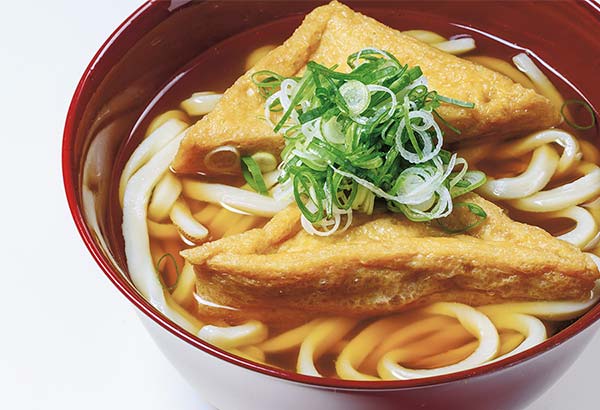

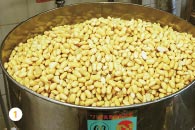
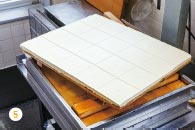

Soaked Tsuru-no-ko soybeans (from Shumei Natural Agriculture)
The result of the compression process to remove moisture
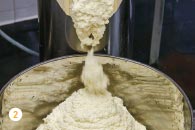
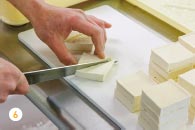
Ground beans
Cutting the pieces into small triangles
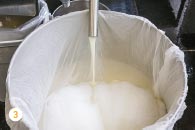
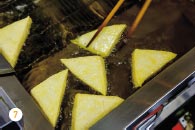
Soymilk with a 7.2 density
Carefully frying each piece
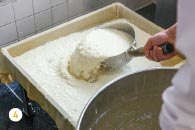
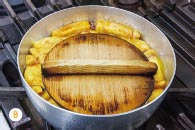
Transferring the thickened soymilk into the mold before the nigari solidifies it
Fried tofu in a vat filled with broth and covered with a drop lid.
The steamer, the compressor, and the electric grinder, all have to
be taken apart and cleaned. Then the containers, cloths, and bowls
have to be washed, and even the floor and back of the drain have to
be scrubbed down. High-quality beans contain extra oil and protein
so they need to be cleaned off right away or they get caked onto
contact surfaces. In most places, a large amount of extra-strength
detergent is used to wash the equipment but our cook uses only the
mildest soaps, hot water, speed, and his hands to clean.
Finally, the steaming square soybean product is taken out and placed on a pan. It now has a firm, solid texture. The pan then is refrigerated until the next day, when the large block is cut into small triangles, which give off a faint scent of soybeans. The cook places about 30 pieces into a large vat of low-temperature, high-grade crapeseed oil, where small bubbles rise from their corners as they puff up. He carefully handles each piece, gently turning them over and submerging them in the oil. If the tofu are not adequately fried, they fall flat. When they are ready, they are transferred to the next vat of high-temperature oil. The cook busily starts to flip the pieces in the oil. The fried tofu must be soft on the inside and keep their shape on the outside as the next batch is placed in the first vat of low-temperature oil. The cook now has to oversee both vats as he repeatedly fries and turns over the pieces. Once their surfaces are firm and don’t cave in, the fried tofu are ready and need to be removed from the oil immediately so that they don’t get too hard. Enveloped with a fragrant flavor and the mildness of tofu, the ready-made fried tofu is so delicious!
Then the next day, after the oil has been blotted from the fried tofu, the cook begins to lightly simmer them in dashi stock. After the flavor of the sake and dashi develops, the cook takes the fried tofu off the heat to let them soak overnight. Finally, the simmered fried tofu is finished and ready to serve warm on top of udon noodles, dancing in broth, with a mound of scallions. One bite, and a fragrant sweetness spreads across your palate. The gentle chewiness fills your body with happiness and a penetrating warmth. This was the first time we learned how much time, labor, and care went into a single piece of fried tofu.
Finally, the steaming square soybean product is taken out and placed on a pan. It now has a firm, solid texture. The pan then is refrigerated until the next day, when the large block is cut into small triangles, which give off a faint scent of soybeans. The cook places about 30 pieces into a large vat of low-temperature, high-grade crapeseed oil, where small bubbles rise from their corners as they puff up. He carefully handles each piece, gently turning them over and submerging them in the oil. If the tofu are not adequately fried, they fall flat. When they are ready, they are transferred to the next vat of high-temperature oil. The cook busily starts to flip the pieces in the oil. The fried tofu must be soft on the inside and keep their shape on the outside as the next batch is placed in the first vat of low-temperature oil. The cook now has to oversee both vats as he repeatedly fries and turns over the pieces. Once their surfaces are firm and don’t cave in, the fried tofu are ready and need to be removed from the oil immediately so that they don’t get too hard. Enveloped with a fragrant flavor and the mildness of tofu, the ready-made fried tofu is so delicious!
Then the next day, after the oil has been blotted from the fried tofu, the cook begins to lightly simmer them in dashi stock. After the flavor of the sake and dashi develops, the cook takes the fried tofu off the heat to let them soak overnight. Finally, the simmered fried tofu is finished and ready to serve warm on top of udon noodles, dancing in broth, with a mound of scallions. One bite, and a fragrant sweetness spreads across your palate. The gentle chewiness fills your body with happiness and a penetrating warmth. This was the first time we learned how much time, labor, and care went into a single piece of fried tofu.